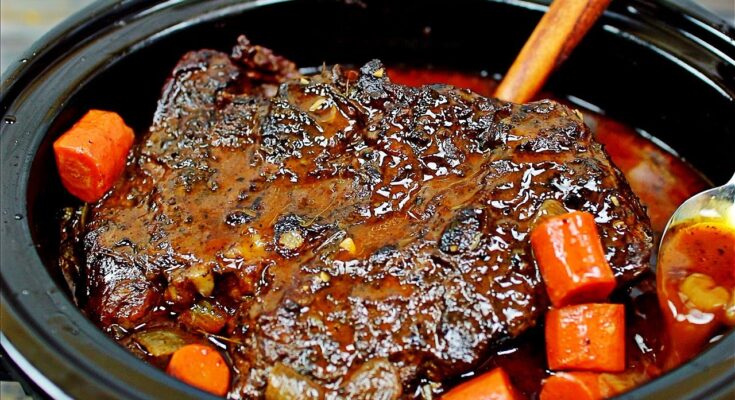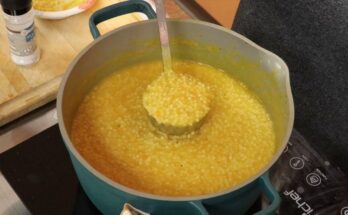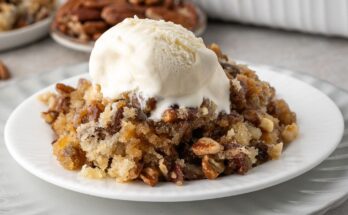Roast Beef Recipe: There’s nothing quite like a perfectly cooked roast beef to bring family and friends together. This classic dish, known for its rich flavor and tender texture, is a staple at dinner tables worldwide.
While it may seem intimidating to prepare, crafting the perfect roast beef at home is easier than you think! With the right steps, tools, and a bit of patience, you’ll have a delicious, juicy roast beef that’ll leave everyone asking for seconds.
Ingredients for Roast Beef
Essential Ingredients
To get started, gather these basic ingredients:
- Beef roast: Choose a cut like ribeye, sirloin, or tenderloin.
- Salt and black pepper: For seasoning.
- Olive oil or butter: To enhance flavor and aid in searing.
- Garlic cloves: Minced or smashed for added aroma.
Optional Ingredients for Extra Flavor
For a gourmet twist, you can include:
- Fresh herbs like rosemary and thyme.
- Red wine or beef broth for basting.
- Dijon mustard for a tangy rub.
- Paprika or onion powder for a spicy kick.
Tools and Equipment Needed
Basic Kitchen Tools
You don’t need a professional setup, just these essentials:
- A sharp knife for trimming and carving.
- A roasting pan or heavy-duty baking dish.
- Aluminum foil to cover and rest the beef.
- A meat thermometer to ensure perfect doneness.
Specialty Tools
Want to elevate your game? Consider these:
- A meat injector for infusing flavors deep into the roast.
- A carving set to achieve picture-perfect slices.
Preparing the Roast Beef
Selecting the Right Cut
The cut of beef you choose makes a big difference. Here are the top choices:
- Ribeye Roast: Rich in marbling and flavor.
- Top Sirloin Roast: Lean but still tender.
- Beef Tenderloin: The most tender (and pricey) option.
Trimming and Tying the Beef
For even cooking:
- Trim excess fat but leave a thin layer for flavor.
- Tie the roast with kitchen twine to maintain its shape during cooking.
Seasoning the Beef
Season generously:
- Rub the beef with olive oil or melted butter.
- Massage in salt, pepper, and any additional spices.
- Let the beef rest for 30 minutes to absorb the flavors.
Cooking the Roast Beef
Preheating the Oven
Set your oven to 450°F (230°C) to ensure a crispy exterior. This initial high temperature helps sear the outside while keeping the inside juicy.
Searing the Beef
Before roasting:
- Heat a skillet over high heat and add a splash of oil.
- Sear the beef on all sides until golden brown. This locks in moisture and adds a caramelized crust.
Roasting the Beef
Transfer the seared beef to a roasting pan and follow these general guidelines:
- Rare: Roast at 325°F (160°C) for 20 minutes per pound (internal temp: 120°F/50°C).
- Medium-rare: 25 minutes per pound (internal temp: 130°F/55°C).
- Medium: 30 minutes per pound (internal temp: 140°F/60°C).
Monitoring and Resting the Roast
Using a Meat Thermometer
For a perfectly cooked roast beef, a meat thermometer is your best friend. Insert the thermometer into the thickest part of the roast, avoiding bones or fat, as these can give inaccurate readings. Here’s a quick temperature guide for doneness:
- Rare: 120-125°F (50-52°C)
- Medium-rare: 130-135°F (55-57°C)
- Medium: 140-145°F (60-63°C)
- Well-done: 160°F+ (71°C+)
Check the temperature frequently towards the end of cooking to avoid overcooking.
Resting the Meat
Once the roast beef reaches your desired doneness, remove it from the oven and tent it loosely with aluminum foil. Resting the meat for at least 15-20 minutes is crucial. This allows the juices to redistribute throughout the roast, ensuring each slice is tender and flavorful. Cutting into the beef too soon will cause the juices to escape, leaving you with a drier roast.
Carving and Serving Roast Beef
How to Carve Like a Pro
Carving roast beef correctly makes all the difference in presentation and texture:
- Use a sharp carving knife for clean slices.
- Cut against the grain. This shortens the muscle fibers, making the meat easier to chew.
- Aim for thin, even slices. This is especially important if you’re serving a larger crowd.
If you tied the roast with twine, be sure to remove it before carving.
Plating Suggestions
Pair your roast beef with sides that complement its rich flavors:
- Potatoes: Mashed, roasted, or baked.
- Vegetables: Steamed asparagus, roasted carrots, or sautéed green beans.
- Gravy or Sauce: Classic beef gravy, horseradish cream, or a red wine reduction. For a beautiful presentation, arrange slices on a serving platter and garnish with fresh herbs like parsley or rosemary.
Tips and Tricks for Perfect Roast Beef
- Start with Room-Temperature Beef: Let the roast sit out for 30-60 minutes before cooking. This helps it cook more evenly.
- Don’t Skip Searing: Searing locks in flavor and creates a delicious crust.
- Use a Rack in the Roasting Pan: This allows air to circulate around the beef for even cooking.
- Baste Occasionally: Use beef broth, wine, or pan drippings to keep the roast moist during cooking.
- Adjust for Altitude: Cooking times may vary at higher altitudes, so monitor the temperature closely.
Common Mistakes to Avoid
- Skipping the Thermometer: Guesswork can lead to undercooked or overcooked beef.
- Overcooking the Roast: This dries out the meat. Stick to the recommended temperatures.
- Not Resting the Meat: Skipping this step leads to lost juices and less tender slices.
- Seasoning Sparingly: Beef loves bold flavors, so don’t hold back on the seasoning.
- Using the Wrong Cut: Tough cuts can be difficult to make tender. Always select a cut suitable for roasting.
Storage and Reheating
Proper Storage Methods
If you have leftovers, here’s how to store them:
- Refrigerator: Wrap the roast in foil or place it in an airtight container. It will stay fresh for 3-4 days.
- Freezer: Slice the beef and store it in freezer-safe bags. It can last up to 3 months.
Label your storage bags with the date for easy tracking.
Reheating Tips
To keep your roast beef moist when reheating:
- Place slices in a baking dish with a splash of beef broth or gravy.
- Cover the dish with foil and heat in the oven at 300°F (150°C) for about 10-15 minutes.
- Alternatively, use a microwave at low power in short bursts, checking often.
Avoid reheating multiple times to preserve the quality of the meat.
FAQs about Roast Beef Recipe
What is the best cut of meat for roast beef?
The best cuts for roast beef are typically top sirloin, tenderloin, or ribeye. These cuts are tender, flavorful, and cook evenly, making them ideal for a classic roast.
How do I season roast beef for maximum flavor?
Season your roast beef generously with salt, pepper, garlic, and herbs like rosemary or thyme. For enhanced flavor, marinate the meat overnight or rub it with a mixture of olive oil and spices before roasting.
What is the ideal cooking temperature for roast beef?
Roast beef should be cooked at 325°F (165°C) for an even, tender result. Use a meat thermometer to ensure it reaches your desired doneness: 125°F (52°C) for rare, 135°F (57°C) for medium-rare, or 145°F (63°C) for medium.
How long should I rest roast beef after cooking?
Rest the roast beef for 15-20 minutes before slicing. This allows the juices to redistribute, ensuring every slice is moist and flavorful.
Can I make roast beef in advance?
Yes! Cook the roast beef, let it cool completely, and refrigerate it. Reheat it gently in the oven, wrapped in foil, to preserve its tenderness.
What are some serving suggestions for roast beef?
Roast beef pairs well with mashed potatoes, roasted vegetables, and gravy. For a lighter option, serve it with a fresh salad or steamed green beans.
By addressing these common questions, you’ll master the art of making a perfectly juicy and flavorful roast beef!
Conclusion
And there you have it—a foolproof guide to preparing the perfect roast beef! With a little care and attention, you can create a dish that’s both impressive and delicious. Whether it’s a special occasion or a cozy family dinner, roast beef never fails to satisfy. Remember, practice makes perfect, so don’t hesitate to experiment with seasonings, cooking times, and side dishes to make the recipe truly your own.



